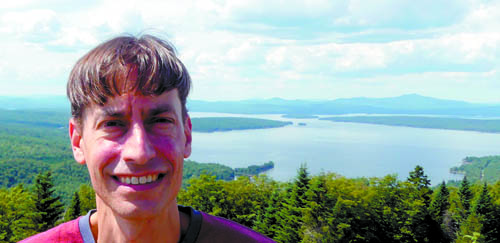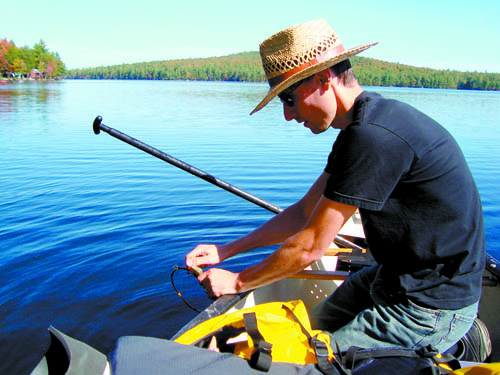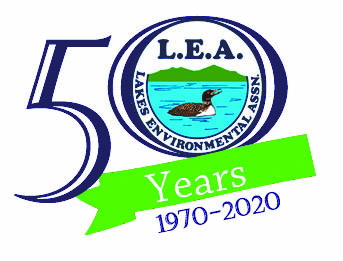LEA celebrates 50th year — Mission stays same; conversation with Executive Director Colin Holme

By Wayne E. Rivet
Staff Writer
When Colin Holme headed to Orono, he had yet to decide upon a career path. He had an interest in ecological and environmental courses, so he chose to pursue a Natural Resources major with a concentration in Marine Sciences.
His senior year, Holme accepted a national exchange to Humboldt State University in California because of its oceanography program.
“There, I got out on the Pacific on small research vessel and learned many of sampling techniques,” he said.
Those sampling technique skills ultimately put Holme onto a path that lead him to Lakes Environmental Association, and ultimately, to the leading role of the area’s water protection organization.
“I came on to LEA as a part-time water testing intern right out of college. My parents were (LEA) members and told me about the internship opportunity. I immediately liked the work and enjoyed Peter (Lowell)’s seemingly casual approach to leadership,” Holme said.
A full-time position opened up the next year and Holme transitioned from water testing intern to Field Service Manager in the summer of 2000.
“For the next decade or so, I was routinely asked when my internship would end each summer!” he recalled. “It was a great time and I was learning and absorbing lots of new things. From road drainage, to town planning and computer mapping. Every new task made the job more interesting.”
Soon, Holme was promoted to Field Service Director and then Assistant Director, all the time taking on new jobs and learning more about LEA and area lakes.
Around 2015, Peter Lowell talked about retiring in a few years. He and the LEA Board of Directors thought Holme would be the best candidate to succeed Lowell.
“With a solid plan and much guidance from Peter and the board, it was smooth transition. That said, you never truly know a job until you have it!” Holme said. “The best part of working for LEA over the last two decades has been developing long-term relationships with our members and other folks in the community who are playing an important part in town government and planning. I like hearing all the different perspectives and then co-creating solutions with folks of different backgrounds that are practical and functional.”
With LEA celebrating 50 years of lake protection, The News reached out to Executive Director Colin Holme regarding the organization’s mission, successes and challenges ahead:

BN: As an organization, what has LEA’s most important contributions to this area been over the past 50 years and how were they achieved?
Holme: I think LEA’s most important contribution to this area over the years is having the community realize the basics of how lakes work so we can all help keep them pristine. People inherently know how valuable they are, but if you don’t know what can hurt or impact our waters, then keeping them healthy is only luck. LEA has strived to have programs, projects and activities that touch on all facets of lakes for all aspects of the community. From contractors, to real estate agents, to municipal officials, lakefront landowners and school children, we try to get the message out to everyone and I think it is working.
BN: Speak on what the early mission was and how it has evolved over time to present day?
Holme: The early mission was focused strongly on assessing water quality. As it still is today, there was no government agency doing routine water monitoring of the lakes in this area. Landowners on the shore wanted to understand the impact of activities that were happening upstream. Today, water monitoring is still one of our core programs, but we also have a strong focus on fixing problems that have been identified and preventing new problems from popping up. This work spans from controlling insidious phosphorus, visible erosion, and (of course) invasive plants. We also have school and adult programs to help people discover on their own the magic of lakes and how they function in the ecosystem. With 50 years of experience now and a state-of-the-art Lake Science Center, our partners and impact have grown statewide.
BN: Obviously, one key to a successful organization is the people involved. Speak generally as to a common theme that brings people under the LEA umbrella and what they have brought to the organization?
Holme: A common theme that runs through our staff is a passion for nature and our lakes and innovation. The two traits go hand-in-hand. The passion brings out the drive and pushes each person individually to take the risks that are associated with new programs and initiatives. We have to keep our core work up-to-date with the today’s issues and that means continually re-inventing programs and re-thinking approaches. We have been blessed with numerous staff members over the years who have done just that.
BN: Who have been some of the major driving forces behind LEA and how did they make a difference?
Holme: Peter Lowell is definitely at the top of that list. He never shied away from risk or from speaking the truth about an issue — even if it was an uncomfortable topic. Roberta Hill, who was with us in the 1990s, was a classic over-achiever who helped build our education and landowner outreach programs. Roberta Scruggs, who was a reporter by trade, helped us modernize our outreach and publications and taught many of us (myself included) how to write a newsletter article! Adam Perron was key in making real headway in our milfoil control work. Bridie McGreavy was another instrumental player who really grew our education and outreach program. And today, we have a fantastic staff that are continually pushing the boundaries of our work to make sure our lakes, ponds, rivers and streams remain clean.
BN: How did you become interested in this line of work?
Holme: When I first applied to work at LEA as a water testing intern, it sounded like a fantastic job! Out on the lakes, learning how they work and sharing this experience with others was magical. Of course, over the years, my job has grown and changed but the awe of our lakes has never gone away.
BN: How did you arrive at LEA, and what important lessons did you learn from Peter Lowell, which you likely apply to your role now as executive director?
Holme: I arrived at LEA thanks to a note in one of our old newsletters advertising a summer water testing internship. What could be better than that?
There were two really important things I learned from Peter. The first is to always remain calm. If you are not calm, you are not making good decisions. He never explicitly told this to me, but I also never saw him lose his cool. The other thing I learned was self-reliance. He continually put me in positions that were outside of my comfort zone and I learned to prepare, research, manage my own time and shoot from the hip when needed. If part of your job is communication, then it helps to fully understand what you are talking about! Peter did not hold my hand through the process, instead he left it up to me to figure out when to jump.
BN: What are the most challenging aspects of being executive director of LEA and how do you contend with them?
Holme: The most challenging part of the job is saying “no” to good projects. New projects take time and resources to implement so they all need to be weighed and compared to the impact from our current work. I would like to say ‘Let’s go for it!’ more often but we can’t always do that.

BN: How has LEA grown since you taking over as executive director?
Holme: Since taking over as director, the Maine Lake Science Center has continued to expand in all directions. I really can’t take credit for this. It is a result of our new Research Director, Dr. Ben Peierls, working his magic and our board as a whole following through on Peter’s initial vision for the Center. Another initiative that I have been pushing is the re-examination of our priorities to make sure we are focusing on the entire watershed of our lakes, rather than just the shoreline. This is not entirely new either, but it needed a push to put it back in the spotlight.
BN: What do you see as the strengths of the organization?
Holme: I believe LEA’s greatest strength is our connection to the community and our reputation and standing in the state as a leader in lake issues. We have been in the game a long time and have acquired a lot of experience in dealing with and protecting freshwaters. When you combine this with respect for our partners and attention to their needs, progress is always right around the corner.
BN: What areas do you hope to improve?
Holme: As director, one of the most important things I do is help to ensure we have adequate funding to keep our programs going. Many people benefit both directly and indirectly from our work but there is often a disconnect and assumption that our funding comes from some aspect of the government. Our number one revenue source is annual membership donations from people who care about our lakes. After that, it is grants (that require lots of writing and reporting) from private foundations. On most of the lakes we cover, less than 30% of the waterfront landowners are LEA members. This is disheartening because these folks have the most to lose if our lakes turn green with algae or become infested with invasive milfoil. One of my biggest goals is to grow our membership. Yes, this will provide more revenue to improve programs, but it will also broaden the impact of our work as more people find out what we are doing and why.
BN: What are some of the biggest concerns ahead and how will LEA respond?
Holme: Climate change is warming our lakes. This is happening throughout the world (lakes are warming faster than the oceans) and we have seen it happening here with the data we’ve collected in-house. As our lakes warm, they will be more susceptible to blue-green algae blooms, which not only hamper recreation and ruin aesthetics – these blooms pose serious health threats to those who live around them. To counteract this trend, we need to make sure the nutrient load to our lakes remains low. This is going to require a watershed approach and taking a hard look at all the tributary streams, rivers and brooks that run into our lakes to ensure the abutting land remains functional as a filter for storm water. The more developed these streams and our waterfront become, the less likely our lakes will be able to ‘weather’ the effects of climate change.
The other big worry is the continual expansion of invasive aquatic plants. We have an amazing team of inspectors and divers keeping these plants at bay right now but as the popularity of boating continues to grow, it will take more resources to keep these plants out of our lakes and under control in the waterbodies that already have them.
BN: LEA can’t be the only entity looking to protect our natural resources. How can the public pitch in and really make a difference?
Holme: Anyone can make a difference by learning and taking action. I encourage everyone to attend an LEA program, schedule a site visit with our staff, or simply peruse our website. If you like what we are doing, become a member! That said, we are not the only ones working to keep our lakes clean. We continually partner with area land trusts like Loon Echo Land Trust, Greater Lovell Land Trust and the Western Foothills Land Trust to help ensure sensitive pieces of the watershed are protected forever. These are great organizations doing important work and together we are making a real difference. Most importantly, take time to think about what you are doing on your own land. This is where you can have the most impact. How will your actions influence water quality both immediately or down the road? If you are not sure, give us a ring!
BN: Finally, you personally, what are you most proud of in regards to LEA?
Holme: Overseeing all the projects we are involved in is awe-inspiring. It feels good to be a part of an organization with goals that will benefit not only our environment, but the whole community. I am just proud to work for LEA.

